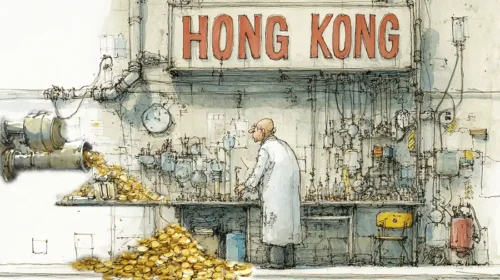Lanvin Nears Completion of U.S. SPAC Listing. Now the Work Begins

The luxury arm of debt-challenged financial conglomerate Fosun looks set to complete its New York listing by year-end, with an aim of breaking even by 2024
Key Takeaways:
- Lanvin Group’s plan for a SPAC listing has moved a step closer to completion with the setting of a Dec. 9 vote on the deal by the SPAC’s shareholders
- The company recorded impressive overall revenue growth in the first half of this year, but results were less stellar for the important Greater China market
By Trevor Mo
As the debt-strapped Fosun International (0656.HK) sells down stakes in some of its many assets to raise much-needed cash, it is also getting ready to list its luxury retailer Lanvin Group, in a deal that has just moved one step closer to completion. But it won’t get much financial assistance from the Lanvin deal, which has been a half year in the making, since that listing will come via a relatively cash-less reverse merger using a special purpose acquisition company (SPAC).
The struggling Fosun first announced its listing plans for Lanvin in March, saying the luxury company would merge with Primavera Capital Acquisition Corp. (PCAC), a SPAC set up by Chinese private equity giant Primavera Capital and listed in the U.S. since January 2021. That plan could soon be consummated as Lanvin announced last Friday that the SPAC’s shareholders will vote on the deal at a meeting set for Dec. 9.
Though nothing is 100% certain, chances are good that shareholders will approve the deal, paving the way for Lanvin to meet its previously promised deadline to become publicly listed by year-end. But that will only be the start of a much longer journey for Lanvin, which will face major challenges carving out a place in the crowded global luxury goods industry.
We’ll review some of those challenges shortly, and also delve deeper into whether Lanvin can serve as an anchor for Fosun to fulfill its luxury ambitions. But first we’ll look at some of its latest financials announced on a voluntary basis one month ago, which indeed showed a company that is making progress. If and when the SPAC merger closes, the company will move to more regular and complete reporting of its financial results on a quarterly basis.
The company recorded revenues of 202 million euros ($202 million) in the first half of this year, up 73% year-on-year. The strong performance was driven by robust growth in Europe and North America, where revenue grew 91% and 58%, respectively. Of its five portfolio brands, all recently acquired and rolled into the new group by Fosun, Lanvin performed the best with sales up 117% to 64 million euros. That means Lanvin accounted for about 32% of the company’s total sales, up from 20% in 2021.
Fosun was no doubt pleased with that result given the brand’s strategic importance, which was probably reflected in the decision to rename its former Fosun Fashion Group to the Lanvin name late last year.
Wolford, the Austrian skinwear specialist Fosun acquired in May 2018, recorded revenue of 54 million euros in the first half of the year, up 29% year-over-year and making up more than a quarter of the revenue total. The company didn’t provide financial data for its other three major brands: Italian luxury shoemaker Sergio Rossi; American womenswear brand St. John Knits and Italian menswear maker Caruso.
It also didn’t provide results on its profitability, though it would be required to do so after completing the SPAC listing. But it said earlier it is still losing money, with Chairman Joann Cheng promising to break even by 2024.
Primavera Capital Acquisition Corp. raised $414 million through an IPO in early 2021, and has a current market value of $538 million. The shares have been thinly traded since then, and their latest closing price of $10.02 is just a tad above the sale price of $10. That appears to show investors think the stock is fairly valued at its current price, which remained unchanged in the two trading days after the company’s Friday announcement.
Challenges ahead
Next, we’ll delve into some of the longer-term challenges Lanvin will face in its future development as a publicly traded company. The company has touted its ownership by a Chinese company as one of its “competitive strengths,” saying it is well positioned to capture growing Chinese demand for luxury goods.
In an earlier prospectus-like document filed to the U.S. security regulator, Lanvin cited a third-party report as saying China is expected to make up half of all luxury goods sales worldwide by 2025, with global spending on the category set to reach $430 billion by then. Last year, Greater China accounted for just 14% of Lanvin’s total revenue, meaning there should theoretically be lots of upside for the company to grow in that market.
Fosun has made a similar pitch for its Fosun Tourism (1992.HK), which similarly contains globally purchased assets like French resort operator Club Med that Fosun was hoping to expand in China. But progress on that front has been slow, hampered most recently by travel restrictions resulting from China’s strict Covid-control measures.
In a similar case, Lanvin’s first-half results show its progress into China has also been slow. Its Greater China sales increased by just 32% year-over-year, according to the October statement, which didn’t give out a specific monetary figure. The company cited the impact of Covid-control restrictions as the main culprit behind the sluggishness.
Having a Chinese owner can also sometimes be a curse for luxury brands, since such owners may be less familiar with the industry and also rely too heavily on debt to finance their purchases.
That was certainly the case for Chinese textile giant Ruyi Group (002193.SZ), whose similar ambition to become China’s first global luxury giant has been rapidly unravelling after it made a series of major acquisitions similar to Fosun’s. The company is currently wrestling with a liquidity crisis after years of debt-fueled expansion in acquiring brands like Lycra, SMCP, Cerruti 1881, and Gieves & Hawkes. It made headlines in June when it lost control of Lycra to some of its creditors.
Ruyi’s unraveling doesn’t necessarily mean Fosun will end up the same. We previously argued that Fosun stands a better chance than Ruyi in its luxury bid because the former has far greater experience at operating international assets and managing acquisition-related debt, even though its heavy debt load has become more problematic in the last few months.
Still, the importance of fashion expertise cannot be overlooked, and Fosun’s lack in that area means the potential for its longer-term success with Lanvin is a big unknown. Equally important is how much support Fosun will give Lanvin as it grapples with its own heavy debt load. The company, which boasts a sprawling network of businesses across the globe, was reportedly planning to sell as much as $11 billion of non-core assets in the next 12 months. Fosun has said finance and pharmaceuticals fall into its core areas, though it hasn’t commented on Lanvin in that regard.
To subscribe to Bamboo Works free weekly newsletter, click here






